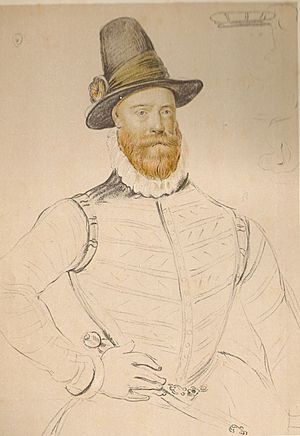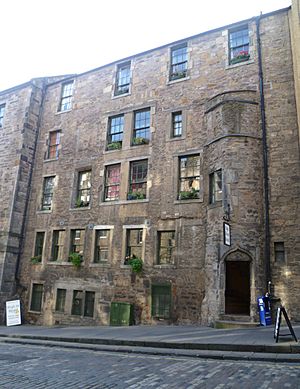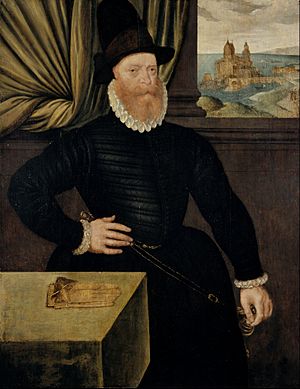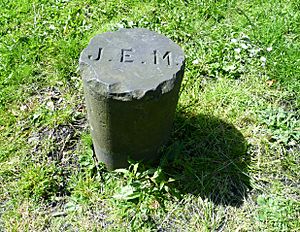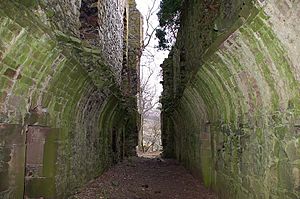James Douglas, 4th Earl of Morton facts for kids
James Douglas, the 4th Earl of Morton (born around 1516 – died June 2, 1581), was a very important Scottish nobleman. He was involved in major political events, including the deaths of Queen Mary's secretary, David Rizzio, and her husband, King Henry Darnley. He was one of the last four regents who ruled Scotland while James VI and I was too young to be king.
Morton was quite successful as a regent. He helped end the civil war that had been going on between those who supported the young King James and those who supported his exiled mother, Mary, Queen of Scots. However, his story ended sadly when he was executed using a device called the Maiden, which was an early version of the guillotine.
Contents
Early Life of James Douglas
James Douglas was the second son of Sir George Douglas of Pittendreich and Elizabeth Douglas. He was likely born around 1516. Before 1543, he married Elizabeth, the daughter of the James Douglas, 3rd Earl of Morton. After this marriage, he became known as the "Master of Morton."
In 1553, James Douglas inherited the title and lands of his father-in-law. These included Dalkeith House and Aberdour Castle. His wife, Elizabeth, had mental health issues, as did her two older sisters. James and Elizabeth's children did not live to be adults, except for three daughters who were later declared unable to manage their own affairs. James also had five children outside of his marriage.
Early Political Actions
At the start of a conflict known as the Rough Wooing war, James and his brother talked with Henry VIII of England. They discussed possibly handing over Tantallon Castle to the English army that burned Edinburgh in 1544. The English commander, Lord Hertford, wrote to Morton in April 1544. He hoped Morton could leave Dalkeith and Tantallon castles in the hands of English allies.
However, four years later, James defended Dalkeith Palace against the English. He was captured in June 1548, badly hurt, and taken to England as a hostage. After the Treaty of Boulogne in 1550, James was exchanged for an English soldier. He returned from England and began using his title, "Earl of Morton."
Involvement in the Scottish Reformation
James's political choices during the Scottish Reformation were unclear at first in 1559. But in February 1560, he signed the Treaty of Berwick. This treaty invited an English army into Scotland to remove the Catholic government of Mary of Guise. He also took part in an unsuccessful trip to England in November 1560. The goal was to arrange a marriage between Elizabeth I of England and James Hamilton, 3rd Earl of Arran.
In 1563, he became Lord Chancellor of Scotland, a very important legal position. Even though he supported the Protestant reformers, he did not join their group in 1565. However, he led the armed group that took over Holyrood Palace in March 1566. This was done to carry out the assassination of David Rizzio. The main plotters then went to Morton's house while a message was sent to get Queen Mary's signature on a "bond of security."
The Queen escaped to Dunbar before signing. Morton and the other leaders fled to England. After being pardoned, Morton returned to Scotland in early 1567. With 600 men, he appeared at Borthwick Castle, where the Queen had gone after marrying Bothwell. Morton was present at the battle of Carberry Hill in June 1567. There, Mary's new husband, James Hepburn, 4th Earl of Bothwell, offered to fight one-on-one. When Patrick, Lord Lindsay accepted the challenge, Morton gave Lindsay his ancestor's sword. Mary stopped the fight and surrendered.
Morton played an active role in getting the queen to agree to give up her throne in July 1567. This happened while she was held prisoner at Lochleven Castle. When Mary escaped from Lochleven, he led the front part of the army that defeated her forces at the Battle of Langside in 1568. He was also the most trusted advisor to the Earl of Moray during Moray's short time as Regent of Scotland.
Becoming Regent of Scotland
Scotland was now ruled by regents for Mary's young son, James VI of Scotland. The country was in a civil war. James Stewart, Regent Moray, Mary's half-brother, was killed in Linlithgow in January 1570. Morton worried that Mary might escape and return to Scotland. He wrote to William Cecil and Queen Elizabeth, asking them to be watchful.
Matthew Stewart, Regent Lennox, died from a gunshot wound after a fight in Stirling. On November 18, 1571, the new Regent, John Erskine, Earl of Mar, sent Morton to talk with Elizabeth's representative. Mar wanted English help to capture Edinburgh Castle from Sir William Kirkcaldy of Grange, who held it for Mary. Morton was asked to arrange for cannons, soldiers, and money for the Scottish troops. He also discussed returning the Earl of Northumberland, who was a fugitive in Scotland, to England.
A week later, Morton wrote again, asking for the same help. He suggested an attack in winter because the Nor' Loch was frozen, making the castle vulnerable. Elizabeth still hoped for peace, but she would consider the cost of an expedition. Morton received some money, and the English rebels were handed over. The agreement for military help was not finished when Mar died in October 1572.
Morton Takes Power
On November 24, 1572, a month after Regent Mar's death, Morton finally achieved his goal. He was elected regent. As Regent of Scotland, Morton expected support from England and Queen Elizabeth. A week after his election, he wrote to William Cecil, Lord Burghley, saying he accepted the role because he was sure of Elizabeth's support, especially for paying his soldiers.
Morton was a strong and capable ruler. His first major success was ending the civil war in Scotland against Mary's supporters. In February 1573, he made peace with the Catholic nobles who supported Mary, with help from Elizabeth's envoy. Edinburgh Castle was still held by Mary's supporters, but after a long siege, it was captured on May 27, 1573. English artillery and soldiers helped in this victory.
The execution of the castle's leaders ended the last chance for Mary to be restored to power by Scottish support. In July 1573, Morton had the king's room at Stirling Castle decorated. He also tried to get back Mary's jewels that were held by others.
Challenges to Morton's Rule
Even though things seemed to be going well for Morton, problems began to appear. The Presbyterian clergy (church leaders) did not like his support for Episcopacy (a different church structure). Also, all parts of the church disliked his taking over church lands. Andrew Melville, a new church leader, strongly opposed any changes from the Presbyterian way. Morton also strictly collected a third of the income from every church property. This money was meant to pay for the King's household.
In 1575, Morton got six "snaphaunce" muskets from Flanders to use as models for new long guns called "calivers." Edinburgh gunmakers were ready to make 50 every week. They also made pistols called "dags." He sent a goldsmith to London to buy tools for the royal mint and silver plate for himself.
In 1577, Morton was given the barony of Stobo. However, over the next few months, opposition to Morton grew. This opposition was led by the Earl of Argyll and the Earl of Atholl, both important Catholics. They worked with Alexander Erskine of Gogar, who was in charge of Stirling Castle and the young King James VI.
Morton was finally forced to resign as Regent in March 1578. But he still kept a lot of his power. He gave up Edinburgh Castle, Holyrood Palace, the Great Seal, and the Honours of Scotland (the crown jewels). He then went to Lochleven Castle, where he spent time creating gardens. On March 10, King James VI announced that many in Scotland disliked Morton's rule, and since Morton had resigned, James would now take over the government. The King was eleven years old.
Queen Elizabeth was surprised and unhappy about Morton's resignation. She felt her influence had helped him become regent, so his forced resignation made her look bad. She told her diplomats to defend Morton. They were to say that if his accusers thought he governed badly, they should have first asked England to pressure Morton to improve his rule.
Morton's Final Years
On April 27, 1578, Morton regained control of Stirling Castle and the King. This brought him back to a powerful position. On August 12, 1578, his opponents' forces faced his army at Falkirk. But a truce was arranged by two Edinburgh ministers and an English diplomat. A peace was made, and a new government was set up in a parliament at Stirling. Morton became president of the council, but Atholl remained a privy councillor in a larger council with members from both sides. Soon after, Atholl died, possibly from poison, and suspicion fell on Morton.
Morton's return to power was short. The only major event was the prosecution of two Hamiltons who still supported Mary. In spring 1579, the Scottish government moved to weaken the Hamilton family's power. Claude Hamilton and his brother John Hamilton fled to England. Morton later denied that this was his idea.
Arrest and Execution
Morton's final downfall came from a different direction. In May 1579, an unusual person publicly told Morton in front of the King that his day of judgment was near. In September, Esmé Stewart, the king's cousin, arrived from France. He quickly became a favorite of James and received lands, the title of Earl of Lennox, and control of Dumbarton Castle. The young James VI was declared old enough to rule on his own in September 1579, and the time of the regents ended.
On December 31, 1580, an associate of Lennox, James Stuart, Earl of Arran, accused Morton of being involved in the death of Darnley. This happened at a council meeting in Holyrood. Morton was immediately arrested and taken to Dumbarton Castle.
Some months later, Morton was found guilty by a court for his part in Darnley's death. The verdict was based on his confession that the Earl of Bothwell had told him about the plan. However, Morton denied actually taking part in carrying out the death.
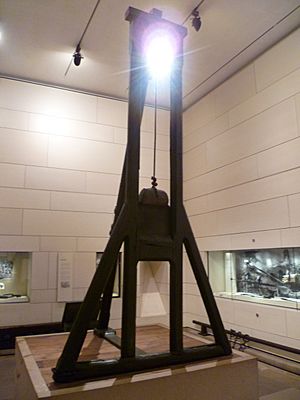
Morton was brought to Edinburgh on May 30, 1581, and held in a house on the Royal Mile. This was about 100 meters from where he would be executed. Before his execution, Morton spoke with two ministers and made a confession.
He was executed on June 2, 1581. The method of his execution was the Maiden, an early form of guillotine. It is sometimes said that he brought it from England, but this is likely a legend. The Maiden was actually ordered to be made by Edinburgh's Town Council in 1564.
Morton's body remained on the scaffold for a day. Then it was buried in an unmarked grave at Greyfriars Kirkyard. His head, however, was placed on a spike on the north side of the old Tolbooth of Edinburgh. It stayed there for eighteen months until it was ordered to be buried with his body in December 1582.
A small stone post in Greyfriars Kirkyard is sometimes said to mark Morton's grave. It has the initials "J.E.M." for James Earl of Morton. However, this marker is probably from the Victorian period and marks a burial plot. It is very unlikely that a marker would have been allowed for an executed criminal, and the initials would have been "J.D." for James Douglas.
Morton's Family After His Death
After Morton's execution, his wife, Dame Elizabeth Douglas, was found unable to manage her own affairs. King James VI appointed a legal guardian to look after her property.
The title of Earl of Morton was passed to John Maxwell, 8th Lord Maxwell. Maxwell had been in disagreement with Regent Morton over the title. While Morton was in prison, Maxwell made an agreement with the Duke of Lennox. Lennox would help Maxwell gain rights to the Morton earldom and become the legal guardian of Morton's three daughters. These daughters, like their mother, were declared unable to manage their own affairs. However, in 1586, the title was given to Archibald Douglas, 8th Earl of Angus, who was Regent Morton's nephew and legal heir.
Regent Morton had sons with other women, including James Douglas of Spott. The barony of Stobo was taken by the Crown and given to the Chancellor of Scotland, John Maitland, 1st Lord Maitland of Thirlestane, in 1587.
Buildings Connected to Morton
James Douglas started building Drochil Castle for himself in 1578, three years before he died. It was only half-built and never finished. The castle ruins overlook Peebles and the valleys of the Tarth Water, Lyne Water, and River Tweed. At Aberdour Castle in Fife, Morton's living quarters still exist. They have a terrace overlooking the Firth of Forth. Morton also expanded his home at Dalkeith Palace, but these parts have since been torn down.
Morton ordered a lot of rebuilding at Edinburgh Castle after the siege. This included the Portcullis Gate, where his symbol (a heart) can still be seen. He also built the famous half-moon battery that faces the castle. On his orders, new galleries, stables, and other buildings were constructed at Stirling Castle and Holyroodhouse. Rooms were also updated and furnished for the King. When he resigned in March 1578, Morton pointed out that the royal houses were "now in better case than they were at the beginning of his regiment."
Morton in Stories
Morton is a character in Liz Lochhead's play Mary Queen of Scots Got Her Head Chopped Off.
Nigel Tranter's novel Lord and Master tells the story of Morton's fall from power and his execution.
Morton was played by the actor Bruce Purchase in the 1971 movie Mary, Queen of Scots.
|


